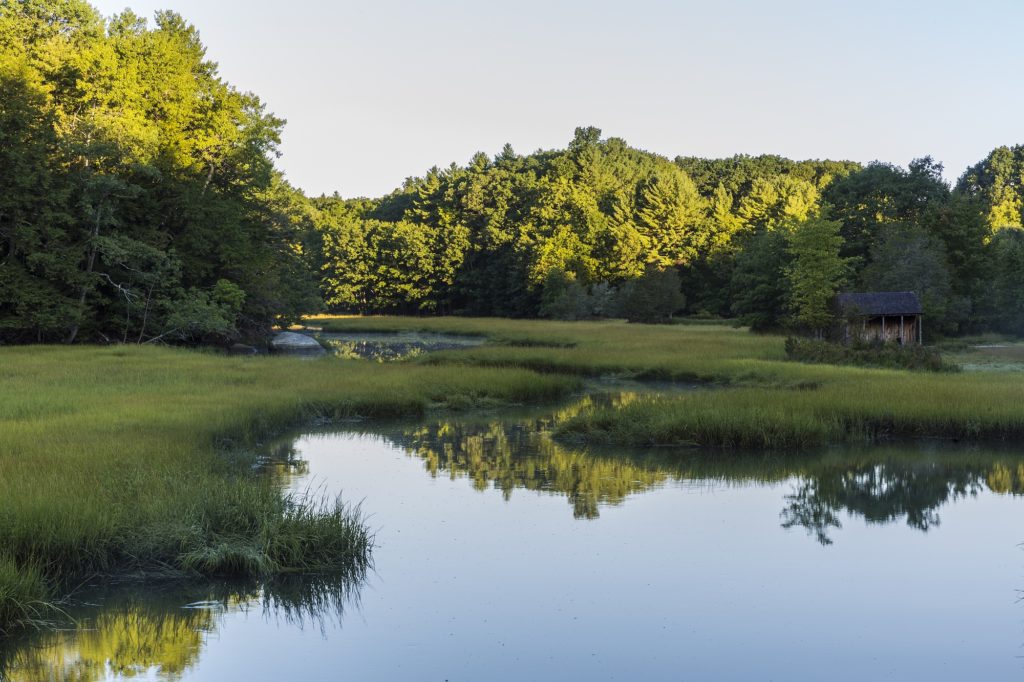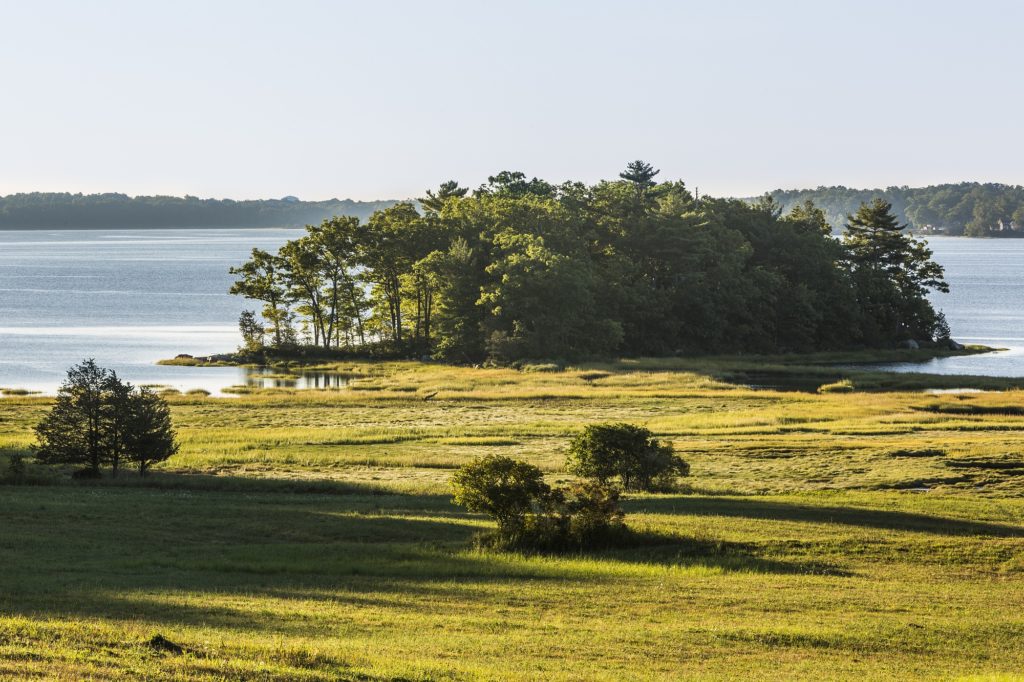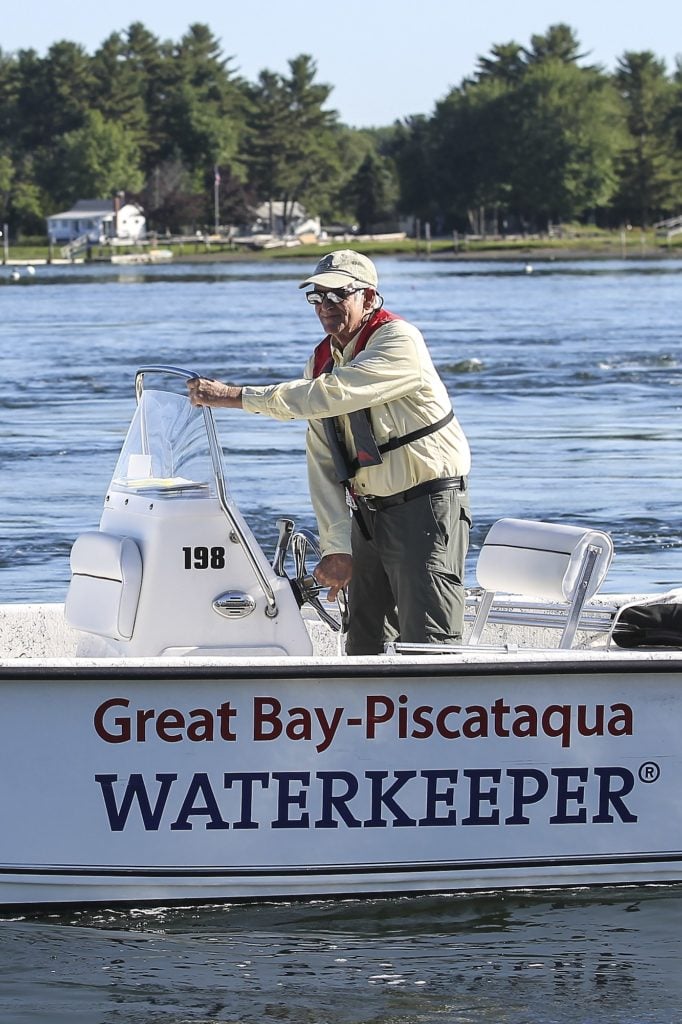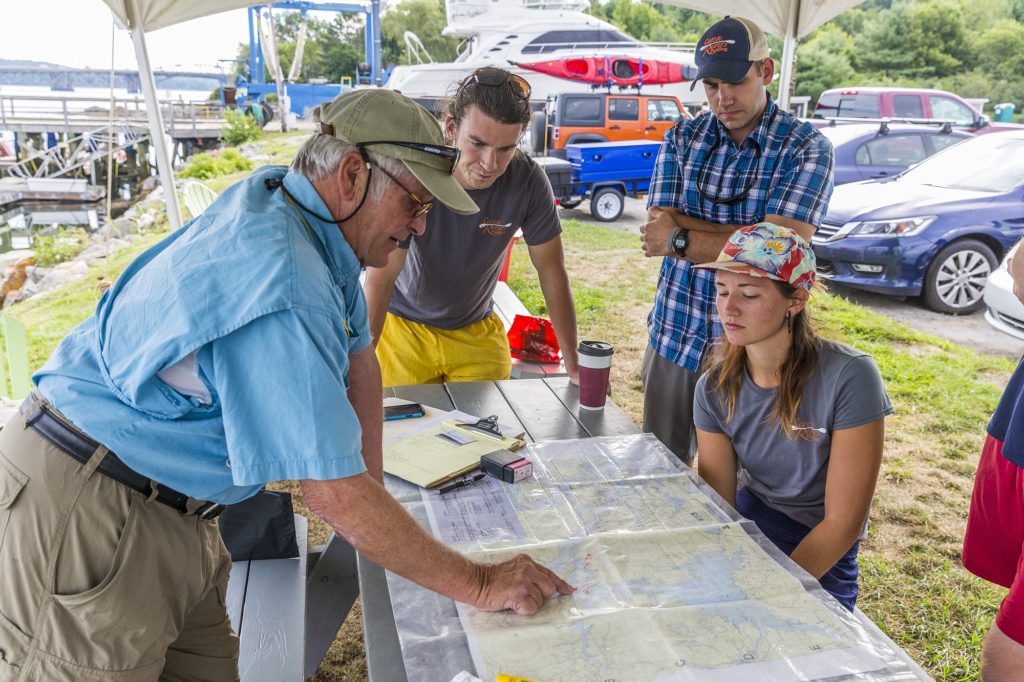New Hampshire’s Great Bay
By: ajcarapella
By Laurie O’Reilly
An estuary with big problems and new hopes.


With its breathtaking panoramas and diverse habitats of salt marsh, mudflats, rocky shores and eelgrass meadows, the Great Bay estuary is a vital part of the landscape of New Hampshire’s seacoast region and southern Maine. Extending inland from the mouth of the Piscataqua River – and including Little Bay, Great Bay, and numerous rivers and tidal creeks – the 13,000-acre estuary is a critical resource for fish, birds and other wildlife. It is also a beautiful destination for boating, fishing, and hiking and, for many who live here, a place for contemplation,
The Great Bay estuary’s economic and cultural histories have been as impactful on the region as its natural endowments. Its waters – once plied by the famous wind-driven Gundalow barges – powered sawmills and tanneries, and its salt hay was once harvested for food and bedding for farm animals. While the shores of Great Bay and Little Bay remain largely undeveloped (in no small part due to the successful effort in the 1970s to stop Aristotle Onassis from constructing a massive refinery there), portions of the Piscataqua River are lined with power plants, oil terminals, and other industrial sites.
More than 400,000 people now live in the 52 cities and towns within the watershed, and as the population has grown and the region becomes more developed, the pressures on this remarkable resource have intensified. Today Great Bay is in jeopardy, its future uncertain. Pollution is pushing its waters toward a tipping point, degrading its health and its habitats. But prodding and persistence from the Great Bay-Piscataqua Waterkeeper have raised local awareness of the bay’s troubles and roused action to resolve them – offering hope for this small but mighty estuary.
For centuries, Great Bay was New Hampshire’s most bountiful source of oysters, until, in 1993, its oyster population was virtually wiped out almost overnight by two parasites. A thousand acres of oysters was reduced to just 50, and while it once took the oyster population two-to-three days to filter the entire volume of water in the bay, it now took the remnant population a year and a half. Though several dedicated local groups have undertaken efforts to bring oysters back, the continued presence of parasites, coupled with the fact that the historic beds are covered in sediment, make it unlikely that the population will ever fully recover.
Then the eelgrass, the cornerstone of the estuary’s ecosystem, began to decline, as it has in estuaries across the world over the last two decades. When healthy, this sub-tidal plant grows in thick meadows, providing essential habitat for fish and crustaceans, producing oxygen, anchoring sediments, improving water-quality, and sequestering carbon even more effectively than the trees in our forests.
In Great Bay, according to Dr. Fred Short, world-renowned seagrass expert and professor at the University of New Hampshire’s Jackson Estuarine Laboratory, 2,900 acres of fairly healthy eelgrass in Great Bay have shrunk over the past two decades to 1,500 acres. This dramatic drop seems to have stabilized in the last three years, but acreage is not the whole story. The eelgrass has also lost biomass, and what has been thinned out has been replaced by macroalgae, such as “sea lettuce,” which do not provide the same important habitat and other benefits to the local ecosystem. Using 1996 as a baseline, Dr. Short estimates that nearly four-fifths of the eelgrass biomass in Great Bay that forms its natural habitat have been reduced from 1,630 metric tons to 348.
In 2007, realizing that increasing pollution was coinciding with this devastating loss of eelgrass, the Conservation Law Foundation (CLF), a New-England-wide environmental-advocacy organization, used the Clean Water Act to leverage regulation of nitrogen in the estuary. The U.S. Environmental Protection Agency began to focus sharply on reducing nitrogen pollution from sewage-treatment plants, while heading off strong pushback from a small group of municipal officials about the costs of upgrading plants, and about whether nitrogen was causing harm in the estuary at all.
“We’ve all heard of climate denial. Here, addressing a pollutant that has had oxygen depleting effects in estuaries across the globe, we were dealing with nitrogen denial,” says Tom Irwin, director of CLF’s New Hampshire office. “That’s when we realized we needed a Waterkeeper. We had been successful getting the regulators to take action, but we also needed local citizens to speak up for clean water and the investments that would get us there.”
CLF was well aware of the Waterkeeper model, having established the Lake Champlain Lakekeeper program in Vermont in 2002. By combining its legal and policy expertise with the proven effectiveness of the worldwide Waterkeeper model, CLF realized it could help build a local movement committed to Great Bay’s protection, and it launched the Great Bay-Piscataqua Waterkeeper program in 2012.
Jeff Barnum was a natural fit for the role of Waterkeeper. As a recreational fisherman along Great Bay and the Piscataqua River, Barnum had witnessed firsthand the effects of pollution, including the dramatic loss of eelgrass habitat, and, during his time as president of the Coastal Conservation Association of New Hampshire, he had focused on the health of the state’s estuarine ecosystems. One of his key accomplishments was the establishment of an oyster-shell-recycling program, in which shells from area homes and restaurants were used to establish new oyster beds in Great Bay, benefiting its water-quality and habitat.
Barnum’s mission as Great Bay-Piscataqua Waterkeeper was three-fold: to safeguard the long-term health of the estuary by finding ways to reduce pollution, to keep a watchful eye and guard against illegal and harmful activities, and, most importantly, to build a stronger voice for the estuary by educating and mobilizing local citizens to protect it.
In any given week, Barnum could be found tabling at a local event, attending a community supper, or giving a presentation at a library or civic-group meeting. He conferred regularly with town leaders, planning boards and partner organizations. During the summer he took local officials, reporters and volunteers out on the water so that they could experience Great Bay’s beauty and better understand its fragile health. And he contributed op-ed pieces and a bi-monthly column about current issues in the bay to local newspapers. In short, he aimed to help people see Great Bay the way he does: as an extraordinary, vibrant and vital place that urgently needed their advocacy before it was too late.
And people listened. Barnum convened a group of more than 30 local volunteers – “Clean Water Advocates for Great Bay” – who help to keep the public’s attention focused on Great Bay by turning out to town meetings and hearings where issues affecting the bay’s health are on the table. In 2015, he worked with Timberland and Seven Rivers Paddling to organize annual cleanups. Since then, more than two dozen volunteers have taken to their kayaks and removed enough debris from the bay to fill more than three dumpsters. These residents learn about this remarkable resource and serve it at the same time.
“The estuary is right in our backyard,” says Barnum, “yet many people haven’t gotten out on the water, and don’t understand it needs help. My job is to help people connect with our local waters. It’s the best way to engage them and keep them involved.”
Perhaps Barnum is most dedicated to raising awareness about the damage caused by nitrogen pollution – and how the solution to that problem lies very much in the hands of the people and communities surrounding Great Bay. Sewage-treatment plants are the watershed’s largest controllable source of nitrogen pollution. Small though it is, the estuary receives discharges from 18 such plants. Yet there’s good news. Major treatment plants are now being upgraded in seven local cities and towns, each of which has entered into a regulatory agreement with the EPA, or is replacing its outdated plant with a new one that must substantially reduce nitrogen discharges.

Now Barnum is also focusing on another major source of nitrogen: local homes and businesses that overuse fertilizer in their quests for perfect green lawns. Most homeowners rarely test their soils to see how much fertilizer is necessary, if any at all. So they use too much, often in the wrong places, at the wrong times. He has set out to educate them as well as managers of local garden and hardware stores about the right ways to fertilize and the harm that can result when the stuff is misused. He has also worked closely with community activists and the program’s Clean Water Advocates to support local fertilizer ordinances.
“It’s all about educating people to become part of the solution,” says Barnum. “The job of cleaning up our waters belongs to us all, and once people understand the challenges, most are happy to do their part.”
This is progress, to be sure, but Barnum knows that the fight to curb this bay-killing pollution is far from over and that the keys to recovery will be persistence and a continuing willingness in communities to invest in clean water. And new threats to the health of our waters and the public are emerging.

The Great Bay estuary wraps around three sides of the redeveloped Pease Air Force Base, which closed in 1991. Research has recently tied perfluorinated chemicals, or PFCs, which were used at the base for fire-fighting, to soft-tissue cancers. PFCs at Pease have contaminated three wells that supply drinking water to the coastal city of Portsmouth. One of these is closed and the other two have been retrofitted with activated carbon filters. The chemicals also have been found migrating from the site of a former landfill nearby that received waste from Pease. Barnum has conducted two rounds of water-sampling that show high levels of PFCs in a brook near the landfill.
While the EPA recently lowered its health-advisory for lifetime drinking-water exposure to PFCs from 600 parts per trillion to 70, Barnum, CLF and others are concerned that even this much lower standard does not sufficiently protect public health
Stormwater magnifies the problem, carrying PFCs, nitrogen and other pollutants from the property into three creeks that flow into the estuary. In January, CLF filed a lawsuit against the Pease Development Authority for its failure to comply with the Clean Water Act’s municipal stormwater management program. Elected officials and local citizens also have organized to introduce legislation, push regulators to act, and encourage responsible parties to actually be responsible.
Ultimately, that is what the Great Bay-Piscataqua Waterkeeper is all about – working with and mobilizing community members and partners to protect and restore the estuary. Barnum knows that no single voice will ever be enough to save Great Bay, and that success thus far has come through listening, convening, guiding, and being guided by the volunteers, partner organizations, legislators, and town officials whose energy and dedication are preserving and restoring Great Bay for the present – and for tomorrow.
Laurie O’Reilly is the chief content officer at the Constitution Law Foundation and is based in Boston, Mass.
Jeff Barnum retired as Great Bay-Piscataqua Waterkeeper in May. Melissa Paly was named the new Waterkeeper in that same month. She brings extensive environmental and communication expertise to the job along with longstanding connections to the watershed.